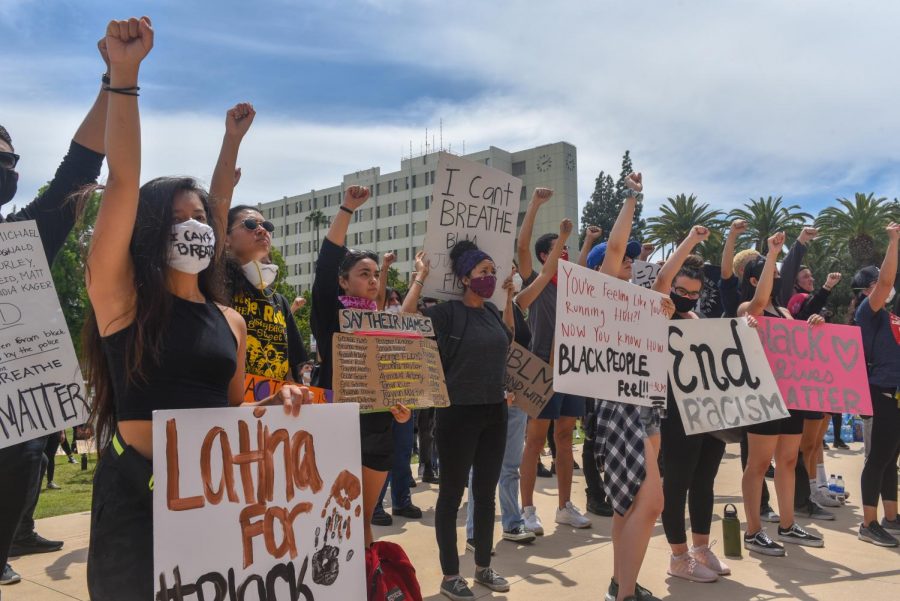A George Floyd protest in front of the University Library on June 2, 2020, in Northridge, Calif.
A history of student speech on campus
Since its origins as San Fernando Valley State College in 1958, CSUN has been a place for students to speak their minds and demand justice from their institution. Here is a historical timeline of how CSUN students have used free speech to criticize the school and how the administration responded to them.
1966
Students at CSUN, then known as San Fernando Valley State College, protested the Vietnam War during U.S. Vice President Hubert Humphrey’s campus speech on space exploration and California’s aerospace industry in September 1966. These anti-war demonstrations were primarily in response to President Lyndon B. Johnson’s decision to send more U.S. troops to Vietnam. After his speech, Humphrey remained on stage to speak to the protestors.
1968
This year marked a period of extreme campus unrest as anti-war sentiments and support for civil rights peaked at universities across the nation. CSUN students continued to protest the Vietnam War, but also threatened to boycott classes until Black and Chicana/o study programs were added. In the same year, members of the Black Student Union took over a floor of the campus administration building and held CSUN President Paul Blomgren and various administrators hostage, demanding an investigation into alleged racism in the school’s athletic department.
1969
The Black Student Union and the Students for a Democratic Society organized campus marches and sit-ins, as well as an open forum in protest of CSUN President Delmar T. Oviatt’s alleged poor treatment of the school’s minority community. Oviatt declared the situation a state of emergency. Claiming that the protesters were planning acts of violence, he banned all campus gatherings and speeches. On Jan. 9, 1969, roughly 100 police officers from the Los Angeles Police Department arrested 275 people who assembled at the campus open forum area, including students and faculty, after an unlawful assembly was declared.
1992
In March of 1992, student activists from the Black Student Union held a rally to protest alleged racism against the Black community across various institutions on campus. The protests came in the wake of rumors that athletic director Robert Heigert had told CSUN coaches to stop recruiting Black athletes for their teams. BSU student leader Karen Brannen, who led the mass of protesters and gave a speech to administrators, also accused the Daily Sundial of inaccurately covering minority issues on campus, including allegedly misquoting her in an interview.
More than 500 students and faculty marched to the administration building, where they confronted CSUN President James Cleary and demanded more representation for the Black community. The demands also included a decrease from a proposed 40% tuition hike, which Brannen claimed would prevent Black students from enrolling, as well as force many students to drop out.
1996
Members of the CSUN community gathered to protest the school’s decision to allow ex-Ku Klux Klansman David Duke to participate in an affirmative action debate with civil rights activist Joe Hicks. Although many students were furious that Duke was allowed on campus, others shifted their focus on the Coalition to Defend Affirmative Action, Integration and Immigration Rights and Fight for Equality by Any Means Necessary, a Bay Area student group that visited CSUN with the intention of derailing the debate. Pro- and anti-debate protestors quarreled with student leader representatives and LAPD officers outside the debate hall. The altercation resulted in six arrests, only one of whom was a CSUN student.
2012
Approximately 70 students marched from the Oviatt Library through campus and ended at Bayramian Hall with signs to protest an enrollment freeze that exclusively permitted graduating seniors to receive permission numbers to add classes that semester. CSUN had implemented the freeze to avoid a $7 million fine for exceeding CSU enrollment numbers. The rally, which was headed by the Students for Quality Education, M.E.Ch.A., and the Central American United Student Association, later moved to University Hall. Here, protesters spoke to CSUN President Harry Hellenbrand and the acting administrator of academic affairs, William Watkins.
2017-2018
Scores of students walked out of classes to protest the CSU system’s implementation of executive order 1100, which would cut many ethnic and cultural studies courses. Protesters gathered at the library steps, before heading to the University Student Union and University Hall to express disapproval of the order to Provost Yi Li. This protest was one of several that occurred in 2017 and 2018 against executive order 1100.
A year later, about 200 students interrupted the faculty senate meeting on campus to protest the revised version of executive order 1100. They also demanded the resignation of faculty senate President Mary-Pat Stein, who had allegedly made racist comments towards a Chicana/o professor. The protesters booed Stein during her speech. Breny Mendoza, chair of gender and women studies, told Stein to resign from her position.
2020
In the wake of the deaths of George Floyd and Breonna Taylor, students led a protest against police brutality. The march began in front of the library and moved onto Nordhoff Street, where LAPD and CSUN campus police later blocked off Reseda Boulevard to let the protesters pass safely. Then, CSUN President Dianne F. Harrison shared her support for the protest in an email to students that day. Establishing an official Black Lives Matter chapter in Northridge was one call to action prompted amid the protest.
